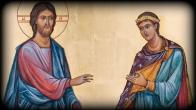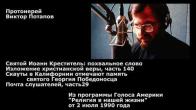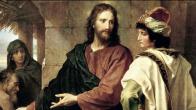You are here
St. Sava I, first archbishop of Serbia
12/25 January
Hierarch Sava has a significance for the whole Orthodox world, as have all the great saints. The heritage of Hierarch Sava of Serbia lives on especially in the Church tradition of the Slavic peoples. The first introduction of the Jerusalem Typicon into Slavic monastic communities is connected with his name. The Serbian Monastery of Chilandar on Athos lives hitherto according to the Typicon of Saint Sava. The edition of the Rudder (the collection of the Church's legal norms, or the canons of the Church and the laws of the state) belonging to the Hierarch became the edition most prevalent in the Russian Church. Such was the contribution of Hierarch Sava to the canonical treasury of Orthodoxy.
Saint Sava, Rastko (Rostislav) in the world, was the son of the Autocrat of Serbia, Stefan Nemania, and Anna, the daughter of the Greek Emperor Romanus. From early childhood, he diligently attended Church services and nourished a special love for monks. At the age of seventeen, having met a Russian monk from the Holy Mountain of Athos, Rastko secretly left his father's home and arrived at the Russian Monastery of Saint Panteleimon. His father, upon learning that his son was on Athos, equipped a whole company, assigning it a loyal commander, and wrote to the ruler of the province in which Athos lay that if they did not return his son to him he would go to war with the Greeks. When the commander arrived at the monastery, he ordered that Rastko not be allowed out of sight. During the evening Divine service, when the soldiers fell asleep intoxicated with wine, Rastko received the tonsure (1186) and sent his worldly clothing, his hair and a letter to his parents.
The monk Sava was able to convince his sovereign parents to receive monasticism. The venerable one's father (the commemoration of Venerable Stefan, Simeon in monasticism, the King of Serbia, is on the 13th of February) struggled in asceticism together with his son in the Athonite Monastery of Vatopedi. On Athos, they restored the Serbian Monastery of Chilandar. In the Monastery of Chilandar, Venerable Sava was ordained a deacon and then a presbyter. For his monastic struggles on the Holy Mountain, the venerable one was deemed worthy of the rank of archimandrite in Thessalonica. In 1219, in Nicea, on the feast of the Dormition of the Most Holy Theotokos, the Ecumenical Patriarch Germanus ordained Archimandrite Sava to the rank of Archbishop of all Serbia. Along with this, Venerable Sava requested from the Greek emperor the right for one seeking the dignity of archbishop to be ordained in Serbia by a council of bishops, which was very important for that time of frequent wars between eastern and western rulers. When he arrived on the Holy Mountain from Nicea, the Hierarch went around to all the monasteries for the last time, venerated all the churches, and, recalling the blessed life of the desert fathers, bade farewell to the ascetics in profound compunction, "going forth from the Holy Mountain, as if from a kind of Divine paradise". On the way from Athos, the Hierarch, dispirited by the difficulty of parting from the Holy Mountain, was hardly able to walk. Only the words of the Most Holy Theotokos, who appeared to the saint in a dream "having me as a surety before the King of all, my Son and God, why art thou still sorrowful?" helped him out of his despondency, changing his grief into joy. In memory of this appearance, the Hierarch commissioned two large icons of the Saviour and the Mother of God in Thessalonica, which were placed by him in the church at Philokalia.
In Serbia, the activity of the Chief Hierarch in ordering the affairs of Church and fatherland was accompanied by numerous signs and miracles. During the Liturgy and the AllNight Vigil, when the Hierarch came to cense the grave of his father, Venerable Simeon, the holy relics streamed forth fragrant myrrh.
In carrying out negotiations with the Hungarian King Vladislav, who had declared war against Serbia, the Hierarch, who was glorified by heavenly signs, not only obtained the desired peace for his fatherland, but also brought the Hungarian monarch to Orthodoxy. Have laid the beginning of the historical existence of the independent Serbian Church, Hierarch Sava likewise promoted the establishment of Serbian statehood. In order to strengthen the independent state of the Serbs, the holy Archbishop Sava crowned his sovereign brother, Stefan, as king.
After the death of Stefan, having crowned his eldest son, Radoslav, as king, Hierarch Sava departed for the Holy Land "to tearfully kiss the holy Tomb of Christ and the fearful Golgotha". Upon returning to his homeland, the Hierarch blessed and crowned Vladislav as king and, for the greater confirmation of the Serbian throne, he betrothed him to the daughter of the Bulgarian prince, Asan. The holy Chief Hierarch went about the whole Serbian land, corrected the monastic rules according to Athonite and Palestinian patterns, built and consecrated a multitude of churches, confirming the Orthodox in the faith. When he had completed his struggle in his homeland, he appointed Hieromonk Arsenius as his successor, ordaining him bishop, and when he had imparted a blessing to all, the hierarch departed on a journey from which he would not return, desiring "to end his days as a wanderer in a foreign land". Passing through all of Palestine, Syria and Persia, Babylon, Egypt and Anatolia, everywhere visiting holy places, conversing with great ascetics, collecting the sacred remains of the saints, the Hierarch ended his wandering in Trnovo, in Bulgaria, in the home of his relative, King Asan, where with spiritual joy he committed his soul to the Lord (+1236). During the transfer of Hierarch Sava's holy relics to Serbia in 1237, the healings were so numerous that the Bulgarians began to murmur against Asan, "Why does he yield up such a treasure". In the homeland of the Hierarch, his precious relics were placed in the church at Mileshevo, granting healing to all who came with faith. The inhabitants of Trnovo continued to receive healings from the remains of the Hierarch's coffin, which the pious Asan had ordered to be collected together and placed in a newly constructed reliquary.
PARISH LIFE
RECENT VIDEOS
Address of our Cathedral
Subscribe to our mailing list
While all the materials on this site are copyrighted, you may use them freely as long as you treat them
with respect and provide attribution on the Russian Orthodox Cathedral of St.John the Baptist of Washington DC.









